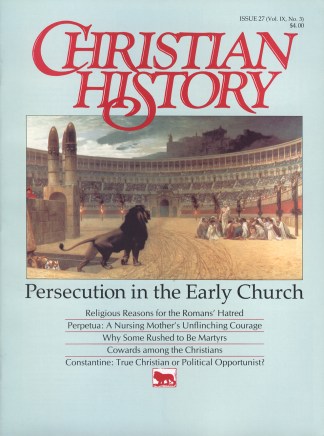Last year I visited Arlington National Cemetery, a peaceful expanse (despite the tour buses) on a slope overlooking Washington, D.C. Its central monument is the huge marble sepulchre dedicated to soldiers whose names elude the government and military historians. No doubt most were young, far from home, and filled with a perplexing mix of fear and bravery when they died. A United States marine keeps constant vigil; at prescribed moments he or she crisply traces steps in front of the Tomb and blows a mournful taps.
Though a few Christians martyred under the Roman Empire are well known—Ignatius, Justin, Blandina, Origen—many are unknown. The Book of Saints (Morehouse, 1989) lists some of them without comment:
“—d. c. 304: Thirty soldiers martyred under Diocletian
“—d. c. 303: Many martyrs who suffered under Diocletian for refusing to give up the holy books
“—d. 303: Twenty-three martyrs who suffered on the Salarian Way under Diocletian.”
Yet no sepulchre rises at the ruins of the Roman amphitheater in Carthage. No one keeps vigil in Lyons. Taps is not sounded throughout the subterranean web of Roman catacombs.
Despite this, the many faceless Christians who died for their faith in the first few centuries do have a lasting and fitting memorial: a church that continues 1700 later.
Who today worships Mithras? Who follows Mani? Who burns incense to Isis, Osi’is, Minerva, and the countless other deities in the Roman pantheon?
Yet the church of Jesus Christ continues unabated, in no small part becuse its early members were wiling to die for him. Among the many reasons that Christianity survived and flourished in the Roman Empire, certainly one of the most compelling, in the words of William H.C. Frend, is that it “never lost its martyr spirit.”
You and I would not and could not hold faith in Christ today, if many of the early Christians had not marched into the arena or toiled in the mines, unbent and unconpromised.
Each time you and I meet a Christian, we are viewing a monument to the unknown early Christian martyrs.
Copyright © 1990 by the author or Christianity Today/Christian History magazine. Click here for reprint information on Christian History.










